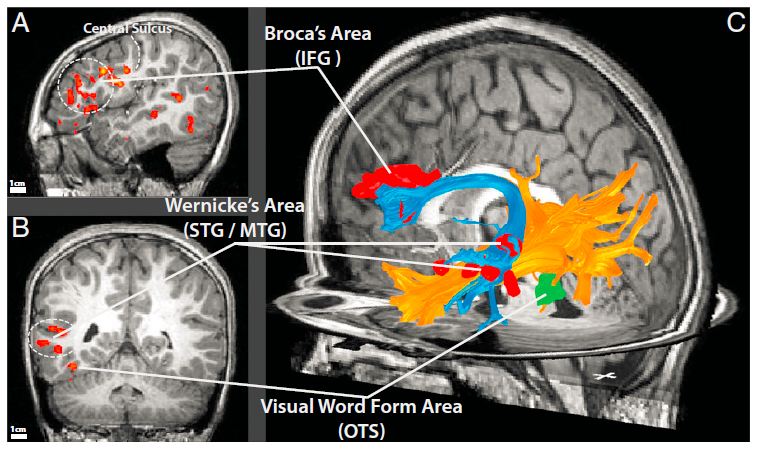Brain connectivity predicts reading skills
October 10, 2012

Essential cortical circuits and white-matter connections for reading. (A and B) Blood oxygen level-dependent responses in a 10-y-old engaged in a rhyming task. In alternating 12-s blocks the subject judged if a pair of written words rhyme or whether two line patterns are the same. The subject’s gray matter was segmented, and regions within the cortex with reliable task-related modulations (P < 0.001, uncorrected) were identified (colored overlay). A sagittal and coronal plane are shown to illustrate the phonological processing-related activations in the inferior frontal gyrus (IFG; Broca’s area) and superior/ middle temporal gyrus (STG/MTG; Wernicke’s area) and the orthographic processing-related activation in the occipito-temporal sulcus (OTS). (C) Responsive voxels from Broca’s area and Wernicke’s area were rendered in 3D and displayed as surfaces within the brain volume (red). Two large fascicles, estimated with deterministic fiber tractography, are shown also. The arcuate fasciculus (blue) may carry phonological signals from the posterior temporal lobe to the inferior frontal lobe. The VWFA activation is rendered as a green surface. The ILF (orange) may carry signals from the VWFA to the anterior and medial temporal lobe. (Credit: Yeatman, J. D., Dougherty, R. F., Ben-Shachar, M., Wandell, B. A./Proceedings of the National Academy of Sciences)
The growth pattern of long-range connections in the brain predicts how a child’s reading skills will develop, according to research published in Proceedings of the National Academy of Sciences, Nature News reports.
Literacy requires the integration of activity in brain areas involved in vision, hearing and language. These areas are distributed throughout the brain, so efficient communication between them is essential for proficient reading.
Jason Yeatman, a neuroscientist at Stanford University in California, and his colleagues studied how the development of reading ability relates to growth in the brain’s white-matter tracts, the bundles of nerve fibers that connect distant regions of the brain.
They tested how the reading skills of 55 children aged between 7 and 12 years old developed over a three-year period. There were big differences in reading ability between the children, and these differences persisted — the children who were weak readers relative to their peers at the beginning of the study were still weak three years later.
The growth of white-matter tracts is governed by pruning, the process that eliminates extraneous nerve fibres and neuronal connections; and myelination, in which individual nerve fibres in the tracts are enveloped by a fatty, insulating tissue that increases the speed of transmission. Both processes are influenced by experience — underused nerve fibres are pruned, whereas others are myelinated — so they occur at different rates and times in different people.
Yeatman says that individual children might benefit from reading lessons that are tailored to their patterns of brain development. In the future, it may be possible to determine exactly when pruning is taking place — children may find it easiest to learn to read at this stage of development, when there is greater potential for remodelling in the brain. “We’d really like to find a way of predicting who’s going to struggle with reading before they start struggling,” he says.